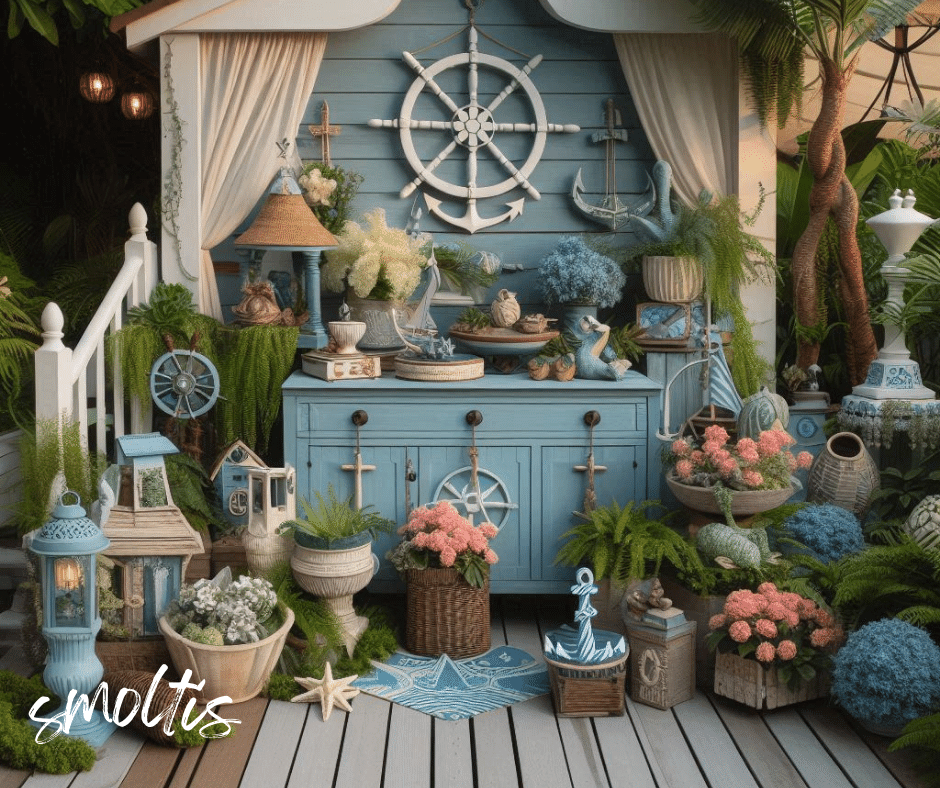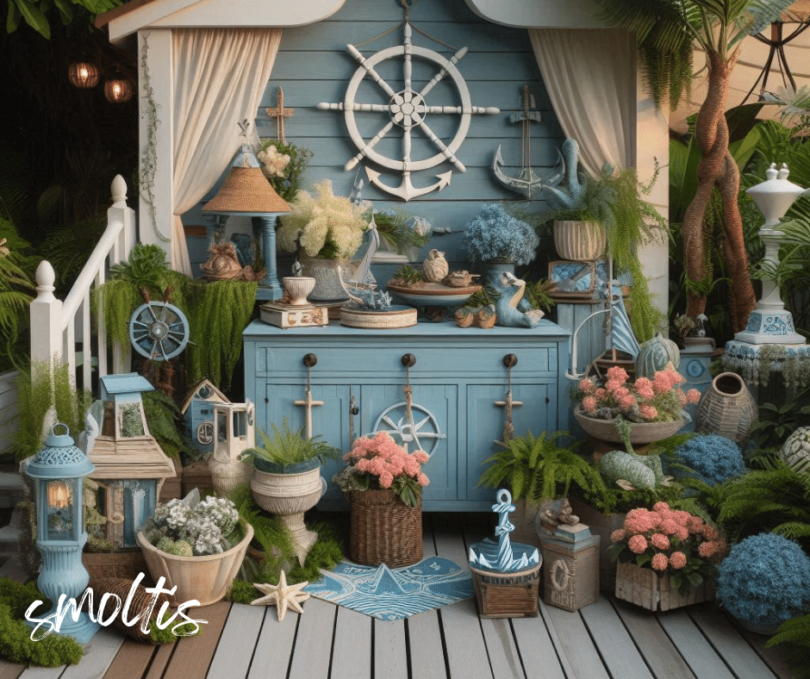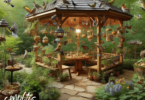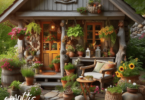Shaded gardens offer a unique canvas for gardeners seeking to create a tranquil oasis inspired by the coastal charm of the seaside. This article explores how to cultivate a nautical-themed garden that thrives in low-light conditions, providing guidance on selecting the right shade-loving plants, incorporating nautical elements, and designing a cohesive outdoor space that evokes a breezy, seaside ambiance.

From the benefits of shaded gardens to the challenges of limited sunlight, this comprehensive guide delves into the art of embracing a nautical theme to overcome the obstacles of gardening in partially or fully shaded areas. Whether you’re creating a woodland-inspired understory or a coastal-inspired retreat, this article will equip you with the knowledge and inspiration to transform your shaded garden into a serene haven.
Key Takeaways
- Shaded gardens can provide a cool, serene retreat from the summer heat and allow for the cultivation of a diverse array of shade-loving plants.
- Embracing a nautical theme can help gardeners overcome the challenges of shaded areas and create a cohesive, visually appealing outdoor space.
- Selecting the right shade-loving plants, such as hostas, ferns, and astilbes, is crucial for success in a shaded garden.
- Incorporating nautical elements, like driftwood, rope, and weathered metal, can help achieve a coastal-inspired ambiance in a shaded garden.
- Strategies for partial shade landscaping, such as the strategic placement of shade-tolerant plants and the use of reflective surfaces, can maximize the available light.
Introduction to Shaded Gardens
Shaded gardens offer a captivating and serene environment, providing a welcome respite from the summer’s heat. These lush oases allow gardeners to cultivate a diverse array of shade-loving plants, creating a visually appealing and low-maintenance landscape. However, the unique challenges of low-light gardens and partial shade landscaping must be carefully navigated to ensure a thriving and cohesive outdoor space.
Benefits of Shaded Gardens
One of the primary advantages of shaded gardens is the ability to create a cool and tranquil retreat. The reduced sunlight helps to moderate temperatures, making these areas a comfortable haven during the warmer months. Additionally, shaded gardens allow for the cultivation of a diverse array of woodland garden and understory plants that thrive in low-light conditions, adding depth and texture to the landscape.
Challenges of Shaded Areas
While shaded gardens offer numerous benefits, they also present unique challenges. The limited sunlight can result in slower plant growth and increased susceptibility to fungal diseases, requiring gardeners to carefully select and maintain shade plants that are well-suited to the conditions. Additionally, the partial shade landscaping can create a sense of enclosure, necessitating thoughtful design strategies to ensure a cohesive and visually appealing outdoor space.
Embracing Nautical Themes
To overcome the challenges of shaded gardens and create a cohesive, visually striking outdoor space, gardeners can embrace a coastal garden or nautical garden theme. By incorporating nautical-inspired elements, such as driftwood, rope, and weathered metal, and utilizing a color palette of cool blues, greens, and whites, gardeners can curate a low-light garden that evokes a serene, seaside ambiance.
Selecting Shade-Loving Plants
Creating a thriving shaded garden requires careful selection of plants that thrive in low-light conditions. From lush shade perennials to vibrant woodland understory plants, there are a variety of options that can transform a shaded space into a serene oasis.
Shade Perennials
Shade-loving perennials, such as hostas, ferns, and astilbes, are the backbone of a shaded garden. These plants not only tolerate limited sunlight but also offer a rich, layered look that adds depth and texture to the landscape. Their diverse foliage and delicate blooms can create a soothing and visually captivating atmosphere in even the darkest corners of the garden.
Woodland Understory Plants
Incorporating woodland understory plants into a shaded garden can bring a touch of natural wonder and whimsy. Native wildflowers and groundcovers thrive in the dappled light of a forested setting, adding pops of color and softening the transitions between different layers of the garden. These understory plants not only enhance the overall aesthetic but also contribute to a more diverse and resilient ecosystem.
| Shade Perennials | Woodland Understory Plants |
|---|---|
| Hosta | Trillium |
| Fern | Tiarella |
| Astilbe | Anemone |
| Hellebore | Epimedium |
| Brunnera | Heuchera |
Creating Coastal Cool Vibes
To achieve a captivating coastal-inspired, nautical theme in a shaded garden, gardeners can incorporate a variety of elements that evoke the breezy ambiance of the seaside. From driftwood and weathered metal to rope and woven baskets, these nautical touches can transform a shaded oasis into a visually striking outdoor retreat.
Incorporating Nautical Elements
Driftwood, with its weathered and organic appearance, makes for an excellent addition to a coastal-themed shaded garden. Arrange pieces of driftwood as focal points, use them to create rustic benches or plant stands, or incorporate them into water features. Rope is another versatile nautical material that can be used to craft hanging baskets, accent fencing, or even to tie back climbing vines.
Color Schemes and Textures
When it comes to creating a cohesive coastal vibe in a shaded garden, color schemes and textural elements play a crucial role. Opt for cool tones of blue and green, which pair beautifully with the lush, shaded foliage. Incorporate white accents to evoke the fresh, clean look of a seaside oasis. Textural elements like woven baskets, smooth river rocks, and weathered metal add visual interest and reinforce the nautical theme.
By thoughtfully incorporating nautical-inspired elements, strategic use of color, and varied textures, gardeners can transform their shaded oasis into a coastal garden that exudes a nautical garden atmosphere, even in areas with shaded gardens or low-light gardens and partial shade landscaping.
Partial Shade Landscaping
Many gardens feature areas of partial shade, which can be tricky to design for but offer unique opportunities. By strategically placing shade-tolerant plants and incorporating reflective surfaces, gardeners can create visually appealing partial shade landscapes that thrive in low-light gardens.
One key to successful partial shade landscaping is selecting plants that not only tolerate but also excel in the dappled light conditions. Shade-loving flowers, such as impatiens and bleeding hearts, can add pops of color, while foliage-focused plants like hostas and ferns provide lush, layered textures. Incorporating these shade-tolerant plants in thoughtful arrangements can transform a shaded garden into a captivating oasis.
In addition to plant selection, the strategic use of reflective surfaces can help maximize the available light in partial shade landscapes. Placing mirrors, light-colored stones, or even a shiny garden sculpture can bounce light back into the shaded areas, creating the illusion of a brighter, more open space. This technique can be especially effective when combined with the placement of shade-loving plants that thrive in the enhanced lighting conditions.
By embracing the unique challenges and opportunities presented by partial shade landscaping, gardeners can create stunning outdoor spaces that seamlessly blend the beauty of shaded gardens with the vibrancy of low-light gardens. With careful plant selection and the strategic use of reflective elements, these transitional zones can become true showpieces in any landscape design.
Shaded Gardens
Shaded gardens present their own unique design challenges, but with the right approach, they can be transformed into lush, tranquil oases. By embracing the principles of low-light garden design and incorporating a variety of shade-loving flowers, gardeners can create captivating outdoor spaces that thrive even in the absence of direct sunlight.
Low-Light Garden Design
When designing a shaded garden, it’s important to focus on vertical elements and foliage rather than relying heavily on flowering plants. Tall, architectural shrubs and trees can help create a sense of depth and layering, while groundcovers and low-growing perennials can fill in the understory. The strategic placement of reflective surfaces, such as mirrors or light-colored rocks, can also help maximize the available light and create the illusion of a brighter space.
Shade-Loving Flowers
Despite the limited sunlight, shaded gardens can still be punctuated with vibrant pops of color from a variety of shade-loving flowers. From the delicate, heart-shaped blooms of bleeding hearts to the lush, tropical-inspired foliage of impatiens, these resilient plants thrive in low-light conditions and add a touch of beauty to the shaded garden. Other shade-loving flowers to consider include astilbes, hostas, and columbines, each offering unique textures and hues to enhance the overall aesthetic.
By embracing the design principles and plant selections suited for shaded gardens, gardeners can create peaceful, visually compelling outdoor spaces that evoke a sense of tranquility and beauty, even in the absence of direct sunlight.
Maintenance and Care
Maintaining a thriving shaded garden requires a tailored approach to watering, mulching, and soil amendments. Gardeners must adapt their practices to the unique challenges posed by low-light conditions, ensuring the plants receive the necessary resources to thrive.
Watering Strategies
In shaded gardens, the reduced sunlight and lower temperatures can lead to decreased evaporation rates. As a result, gardeners must adjust their watering schedules to accommodate these conditions. Overwatering can be just as detrimental as underwatering, so it’s essential to monitor soil moisture levels and water plants only when the top inch or two of soil has dried out.
Mulching and Soil Amendments
Applying a layer of organic mulch, such as wood chips or shredded leaves, can help retain moisture in the soil and suppress weed growth. Additionally, incorporating compost or other nutrient-rich amendments into the soil can enhance its fertility and structure, providing the necessary support for shade-loving plants. Regular soil testing can help gardeners determine the optimal nutrient balance for their shaded garden oasis.
FAQ
What are the benefits of shaded gardens?
Shaded gardens can provide a cool, serene retreat from the summer heat and allow for the cultivation of a diverse array of shade-loving plants. They can also help create a lush, layered look in the landscape.
What are the challenges of growing plants in shaded areas?
Limited sunlight can present obstacles, such as slower plant growth and the potential for fungal diseases. Gardeners may need to be strategic in their plant selection and design to overcome these challenges.
How can a nautical theme be incorporated into a shaded garden?
Incorporating nautical elements like driftwood, rope, and weathered metal can help create a cohesive, coastal-inspired look in a shaded garden. Selecting a color scheme featuring cool tones of blue, green, and white, and using textures that evoke a seaside ambiance, such as woven baskets and smooth river rocks, can also contribute to the nautical theme.
What are some good shade perennials to grow in a shaded garden?
Shade-loving perennials like hostas, ferns, and astilbes can thrive in low-light conditions and provide a lush, layered look to the garden.
How can gardeners design for partial shade areas?
In partially shaded areas, strategically placing shade-tolerant plants and using reflective surfaces to maximize available light can help create visually appealing landscapes.
What are some shade-loving flowers that can add color to a shaded garden?
Shade-loving flowers, such as bleeding hearts, impatiens, and begonias, can provide pops of color in a shaded garden setting.
What are some maintenance tips for shaded gardens?
Adjusting watering schedules to account for reduced evaporation in shaded areas and using organic matter to enrich the soil and support shade-loving plants are crucial maintenance strategies for shaded gardens.







